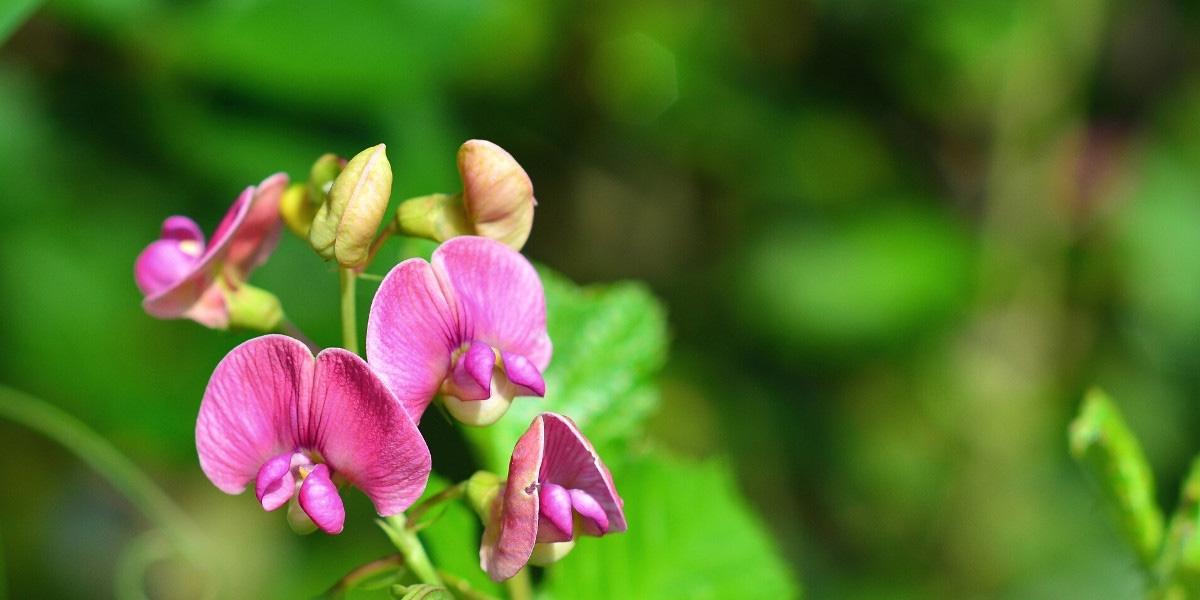
Lathyrus: Planting, Growing, and Caring
Contents
The Lathyrus in a few words
- Lathyrus, or Everlasting Pea, is a beautiful climbing herbaceous plant, very similar to the sweet pea, but with perennial growth!
- In summer, it produces delicate pea-like flowers, usually in white, pink, or mauve hues.
- This is a hardy and easy-to-grow plant, perfect for naturalistic gardens.
- It thrives in rich, deep, moist, and well-draining soil.
The word from our expert
In the genus Lathyrus, the most well-known are the annual sweet peas (Lathyrus odoratus), but there are many perennial peas, known as everlasting peas, which are highly decorative in the garden! Their advantage is that they remain in place from one year to the next. Their very delicate flowers, similar to those of sweet peas, are much appreciated, although they are not fragrant. They come in a beautiful palette of soft and luminous colours: white, pink, mauve, carmine… The most commonly cultivated perennial peas are the Lathyrus latifolius, lovely climbing herbaceous plants that flower in summer. Also discover the Lathyrus vernus, with its blue-violet spring flowering, the Lathyrus maritimus, particularly suited to coastal gardens, the Lathyrus aureus, with yellow flowers, and the Lathyrus niger, with its small purplish-pink flowers and very delicate, finely divided foliage.
Lathyrus thrive in sun or partial shade, in rich, deep, moist, and well-drained soil. They are easy-going, undemanding, and fully hardy plants. They propagate quite easily by sowing. The climbing species need a support to cling to and can reach up to 2 m in height! They are perfect for naturalistic and cottage gardens and also find their place in romantic-style gardens. Discover all our tips for growing everlasting peas or Lathyrus in this guide: which variety to choose, how to plant, care for, and pair them in the garden!
Botany
Botanical data
- Latin name Lathyrus sp.
- Family Fabaceae
- Common name Everlasting Pea, Perennial Pea
- Flowering from June to August (except for Lathyrus vernus, which flowers from April to May)
- Height from 40 cm to 2 m
- Sun exposure sun or partial shade
- Soil type fertile, moist and well-drained
- Hardiness - 15 to – 20 °C
Lathyrus or Everlasting Peas comprise around 160 species of perennial or annual herbaceous plants. They are primarily native to the temperate regions of the Northern Hemisphere: found in Europe, North America, Asia, as well as North and East Africa, and some temperate regions of South America. They grow particularly in meadows, fallow lands, grassy slopes, and open woodlands. Many species are found wild in France. Examples include the Lathyrus latifolius, the Lathyrus vernus, and the Lathyrus odoratus (sweet pea). The latter is an annual, while most other Lathyrus species are perennials.
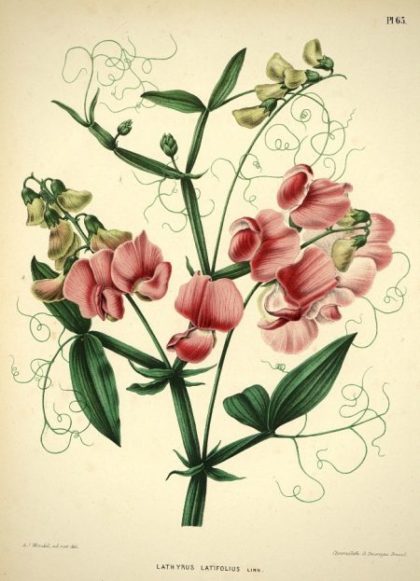
Lathyrus latifolius: Botanical illustration
Lathyrus belongs to the Fabaceae botanical family. The everlasting pea is thus a cousin of beans, peas, clovers… This family includes many ornamental plants, such as wisteria, Judas tree, lupin, or broom.
Lathyrus often has a climbing habit, attaching to supports using tendrils. Without a support to cling to, these climbing species adopt a creeping, ground-covering habit. There are also many species with a bushy or tufted habit, with upright stems. The shortest Lathyrus species do not exceed 40 cm in height, while climbing species (notably Lathyrus latifolius) can reach up to 2 m in height.
Perennial everlasting peas flower in summer, from June to August or September, except for the Lathyrus vernus, which flowers in spring from April to May. It is also known as the Spring Pea.
Everlasting peas produce clusters of papilionaceous flowers, appearing in the leaf axils. Each cluster bears, depending on the species, between 3 and 15 hermaphroditic flowers, 1 to 2 cm long. Very delicate, they closely resemble pea flowers. They consist of five small green sepals and five petals. The petals form a banner in the upper position, two lateral wings, and the keel made of two petals. The latter encloses the pistil and the 10 stamens.

Flowers of Lathyrus vernus (photo Klaus Selle MA), Lathyrus latifolius ‘White Pearl’, Lathyrus latifolius ‘Red Pearl’, and Lathyrus aureus (photo Franz Xaver)
The flowers come in a beautiful palette of colours, both bright and delicate. They are most often pink, white, mauve, or purple, and fit perfectly into romantic or naturalistic gardens. The Lathyrus aureus stands out with its yellow flowers.
Unlike sweet peas (Lathyrus odoratus), the flowers of perennial everlasting peas are not fragrant. However, they are melliferous and attract bees, butterflies, and other pollinating insects.
Their flowers integrate beautifully into rustic-style bouquets. They also add lightness to bouquets alongside larger, more imposing flowers like roses or lilies.
Everlasting peas have finely divided foliage, ranging from soft green to bluish. The leaves consist of ovate to oblong leaflets. The leaves of Lathyrus latifolius are simply composed of two ovate leaflets and a winged petiole, ending in a branched tendril. Its stems are also winged.
Like other Fabaceae, Lathyrus forms nodules on its roots: a symbiotic association with a bacterium that fixes nitrogen from the air. This allows Lathyrus to thrive in poor soils while enriching the soil with nitrogen!

Leaves of Lathyrus latifolius, Lathyrus niger, and Lathyrus vernus (photos: Stefan Lefnaer / Franz Xaver)
The fruit of Lathyrus is a flattened pod resembling a bean, which opens at maturity to release the seeds. These seeds can be harvested for sowing. Although they belong to the same family as peas and beans, the pods and seeds of Lathyrus are not edible and may cause stomach discomfort if ingested.
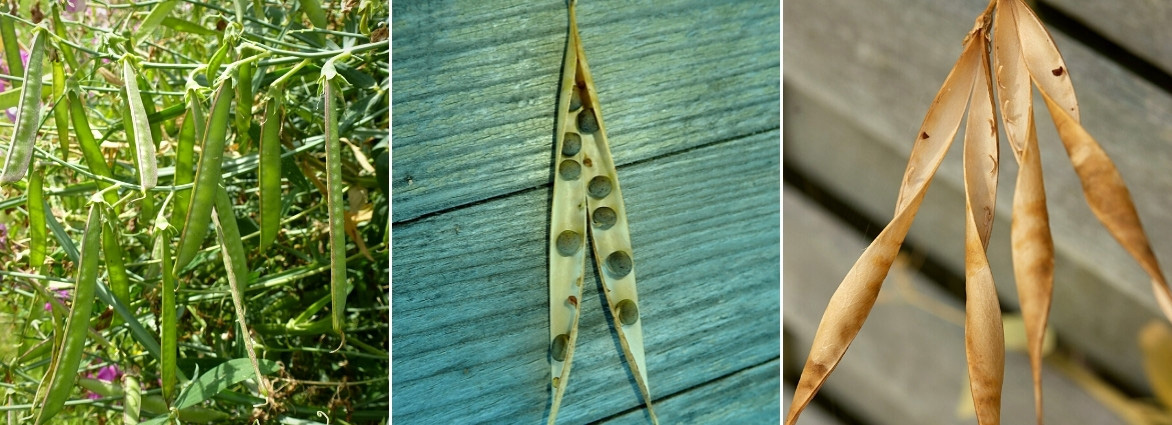
Pods of Lathyrus latifolius (photos: Katrin Schneider / Salicyna / Wouter Hagens)
The main varieties of Lathyrus
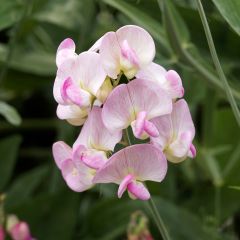
Lathyrus latifolius Pink Pearl - Broadleaf Sweetpea
- Flowering time July to October
- Height at maturity 1,80 m
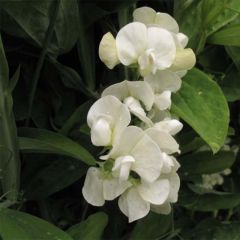
Lathyrus latifolius White Pearl - Broadleaf Sweetpea
- Flowering time July to October
- Height at maturity 1,80 m
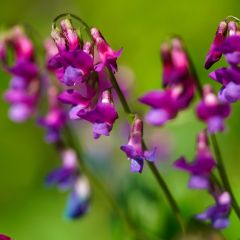
Lathyrus vernus
- Flowering time May, June
- Height at maturity 40 cm

Lathyrus latifolius Red Pearl - Broadleaf Sweetpea
- Flowering time July to October
- Height at maturity 1,80 m
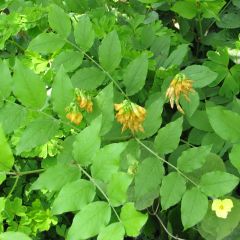
Lathyrus aureus
- Flowering time June to August
- Height at maturity 40 cm
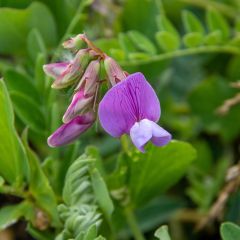
Lathyrus maritimus - Beach Pea
- Flowering time July to September
- Height at maturity 40 cm
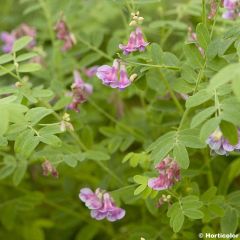
Lathyrus niger
- Flowering time July to September
- Height at maturity 55 cm
Discover other Lathyrus
View all →Available in 0 sizes
Available in 2 sizes
Available in 2 sizes
Available in 2 sizes
Available in 1 sizes
Available in 1 sizes
Available in 1 sizes
Available in 1 sizes
Planting
Where to Plant Lathyrus?
Plant Lathyrus in a sunny or partially shaded spot, in fresh, fertile, humus-rich, well-drained soil. It is relatively drought-resistant but dislikes waterlogged conditions, which can cause its roots to rot. If your soil tends to retain water, don’t hesitate to add coarse sand or gravel, or plant on a mound to improve drainage. Lathyrus latifolius thrives in chalky soils but is quite tolerant of pH levels.
Remember to provide a support for Lathyrus latifolius to climb on: trellis, stakes, wire mesh… In the wild, the everlasting pea often climbs nearby bushes and plants. Without support, it will spread and behave like a ground cover. The species Lathyrus vernus, Lathyrus niger, and Lathyrus maritimus are not climbing plants and therefore do not require staking.
Lathyrus maritimus is an ideal plant for coastal gardens. It grows naturally in sandy or stony, poor, and well-drained soils. With its long creeping stems, it helps stabilise dunes and unstable soils.
When to Plant?
Plant Lathyrus in spring or autumn, avoiding periods of frost or extreme heat.
How to Plant?
If planting multiple young plants together, space them at least 30 cm apart.
- Soak the Lathyrus in a basin of water to rehydrate the root ball.
- Dig a planting hole two to three times the size of the root ball.
- Add some compost and, if needed, sand or gravel (for drainage), mixing it with the soil.
- Place the Lathyrus in the planting hole.
- Backfill with the substrate and lightly firm it down.
- Water generously.
- You can apply organic mulch around the base of the Lathyrus to retain soil moisture.
- If it’s a climbing species (e.g., Lathyrus latifolius), provide a support for it to climb and begin guiding its shoots onto it. Later, the Lathyrus will attach itself using its tendrils.
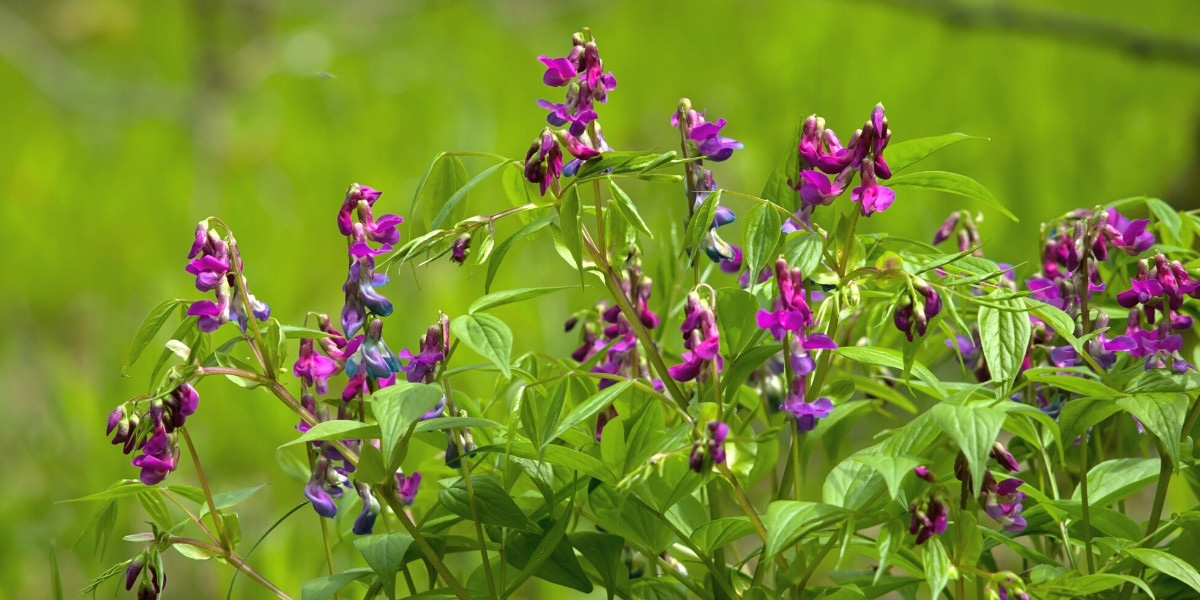
The spring pea, Lathyrus vernus
Maintenance
The everlasting pea is an easy-going plant, requiring very little maintenance. Once established, Lathyrus latifolius is quite drought-resistant. However, to encourage abundant flowering, water regularly in spring and summer, especially during dry spells, but avoid excessive moisture, which could cause the roots to rot (always let the substrate dry out between waterings). Similarly, when watering, avoid wetting the foliage. Feel free to mulch the soil around the base of the Lathyrus to keep the soil cool for longer and to limit weed growth. Additionally, as the mulch decomposes, it will enrich the soil by adding organic matter.
The Lathyrus will appreciate it if you add well-decomposed compost at the beginning of spring. This will enrich the soil and encourage flowering. If you grow it in a large pot or container, you can apply liquid fertiliser every two weeks in spring and summer.
In spring, pinch the stems to encourage the Lathyrus to branch out, resulting in denser and bushier young plants.
In summer, we recommend removing faded flowers. This will encourage the plant to produce new flowers. However, if you wish to propagate the plant, leave a few faded flowers on the young plant to collect the seeds from the pods.
Snails and slugs enjoy nibbling on the leaves and young shoots of the Lathyrus. To protect your young plants, you can use slug pellets, for example, or create a slug trap. Don’t hesitate to check out our guide “Slugs: 7 Ways to Fight Them Effectively and Naturally”.
The Lathyrus is sometimes attacked by aphids, which pierce the plant to extract the sap, weakening it. To get rid of them, you can spray with black soap (diluted at a rate of 15 to 30 g per litre of water) or, as a last resort, use a pyrethrum-based insecticide. The Lathyrus can also be affected by downy mildew or powdery mildew, fungal diseases.
Multiplication
The best way to propagate Lathyrus is by sowing. It is also possible to divide the young plants.
Sowing
In the ground
You can sow sweet pea seeds in autumn (September-October) or early spring.
- Soak the seeds in lukewarm water for 24 hours.
- Prepare the ground: loosen the soil to a depth of about 10 cm, remove weeds and larger stones, and level the soil to create a fine, flat seedbed.
- Sow the seeds in clusters (groups of 2 to 3 seeds), spaced about 30 cm apart.
- Cover them with a layer of soil (2 to 3 cm thick).
- Water gently with a fine spray.
- Continue to water regularly until germination, but avoid overwatering.
In pots
We recommend sowing sweet peas in pots in late winter or early spring (March-April).
- Soak the seeds in lukewarm water for 24 hours.
- Prepare a pot with compost.
- Sow the seeds.
- Cover them with 2 to 3 cm of compost, then lightly firm the surface.
- Water gently with a fine spray.
- Place the pot in a sheltered, bright spot, away from direct sunlight.
- Ensure the substrate remains slightly moist until germination, but avoid overwatering to prevent damping off.
- Once the seedlings are large enough to handle, transplant them into individual pots.
Association
The Lathyrus will easily find its place in a naturalistic garden. It will be perfect to accompany the small white or pink flowers, shaped like butterflies, of the Gaura lindheimeri. Plant alongside them penstemons, Buenos Aires vervain, and yarrows. Also enjoy the delicate flowering of knautias and scabious. Integrate some ornamental grasses, such as Pennisetums and Stipas: their fine foliage and light spikes will give your garden a wild meadow feel. Don’t forget wildflowers, such as poppies and cornflowers!
Discover our selection of the most beautiful perennial plants for a naturalistic garden.

Sweet peas blend wonderfully into a rustic and naturalistic garden! Penstemon ‘Souvenir d’Adrien Regnier’, Lathyrus latifolius (photo Forest and Kim Starr), Gaura lindheimeri ‘Siskiyou Pink’, Scabiosa atropurpurea ‘Scarlett’ (photo Annie’s Annuals), cornflowers and poppies
The pink or white-flowered sweet peas, such as Lathyrus latifolius ‘Pink Pearl’ or ‘White Pearl’, will blend perfectly into a romantic garden. They will accompany the flowering of roses, clematis, lilies, and foxgloves. For shrubs, opt for the stunning flowering of Deutzia setchuenensis ‘Corymbiflora’, and Ceanothus pallidus ‘Marie Simon’. Plant alongside them airy and delicate blooms, such as baby’s breath and gaura. Also integrate silver foliage, like that of Stachys byzantina or artemisias. They will enhance the soft and delicate look of the bed and beautifully complement the white and pink blooms!
Discover our inspiration page “Romantic Garden”
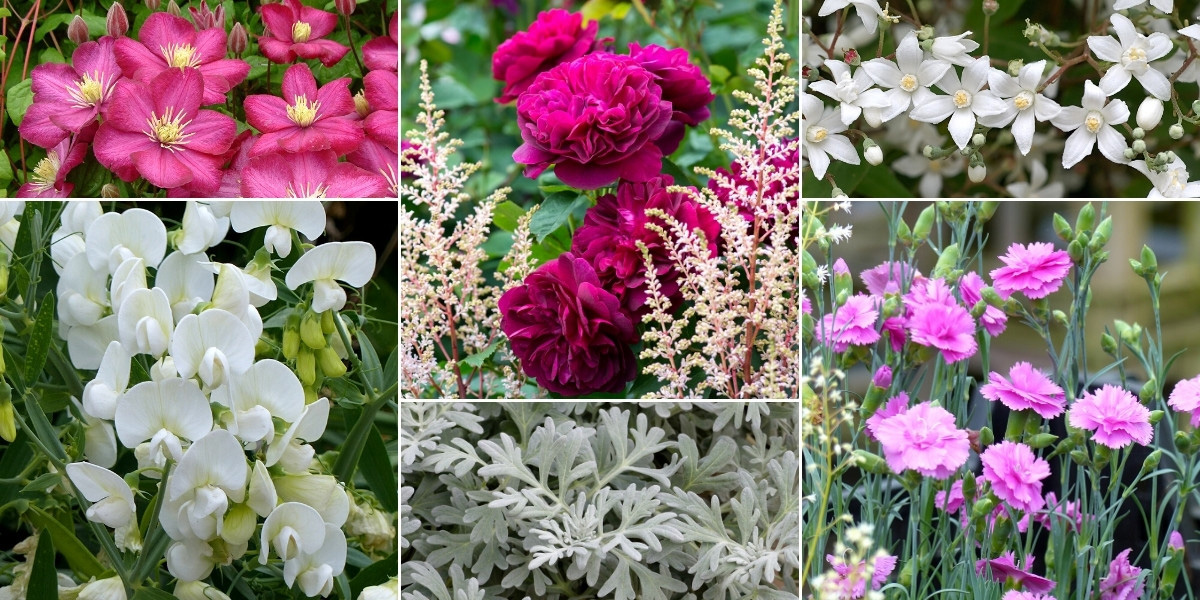
You can create a beautiful romantic ambiance with white or pink-flowered sweet peas! Clematis ‘Ville de Lyon’, David Austin Rose ‘Darcey Bussel’, Deutzia setchuenensis ‘Corymbiflora’, Lathyrus latifolius ‘White Pearl’, Artemisia stelleriana ‘Silver Brocade’, and Dianthus plumarius ‘Scent First Tickled Pink’
The Lathyrus maritimus, on the other hand, will be perfect for a coastal garden. Its summer flowering will accompany that of the Sea Holly (Eryngium maritimum), Delosperma cooperi, agapanthus, and Sea Thrift, Armeria maritima. Plant alongside them agaves, for their exceptional graphic appeal and exotic style! Also discover the Anthyllis barba-jovis, a stunning Mediterranean bush with finely cut, silver-grey foliage.
Pair Lathyrus vernus with spring blooms. Consider, for example, spring bulbs: tulips, daffodils, grape hyacinths, fritillaries… You can also integrate Bleeding Hearts (Dicentra spectabilis), which offer charming white or pink heart-shaped flowers.
- Subscribe!
- Contents































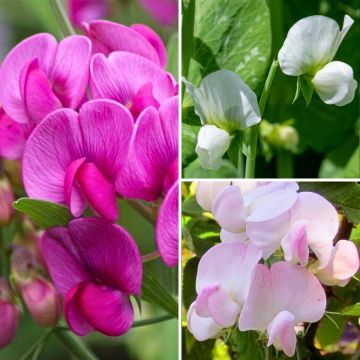

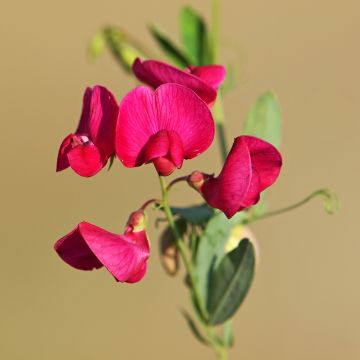





Comments